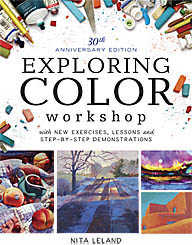Book Review: The Painter's Handbook
The revised and expanded version of The Painter's Handbook by Mark David Gottsegen was published this year by Watson-Guptill. This updated technical reference on all media includes information on hazardous materials and safety in the studio. The book bears a close resemblance to The Artist's Handbook, the classic Ralph Mayer reference book that is still available. However, the Gottsegen book has more current information. Some of the old techniques used in the past are described in both books, so you might want to reference both if you're interested in these. However, you'll want to know what improvements have evolved through the years in different media.
I was disappointed in the chapter on pastels, with several pages on making your own and just one paragraph on commercial pastels. (I couldn't find a word on the difference between hard and soft pastels). On page 27, where a variety of media are described and compared, there is just one sentence about pastel.
I was bothered by some minor innacuracies. On p. 24, the author states that rough watercolor paper is called "not," but I believe that term is used for cold-press paper. On p. 37 we learn about "adonized aluminum," a typo that shouldn't appear in a technical book. An * with text in bold type are used throughout the book to call attention to specific dangers, but on p. 58 there is no such marking on the text referring to lead-white paint. On p. 126 it is stated that ultramarine was "accidentally discovered" in 1828, but my sources say that chemists in France and Germany had been making a concerted effort for some time to combine known components of ultramarine into a suitable substitute and were spurred on by a reward offered for the best formulation. These are minor points, but a bit worrisome in a technical reference.
The book covers a broad range of topics, from stretching canvas and paper to framing, with great detail in pigment descriptions. If you're interested in the technical side of art, you should probably have The Painter's Handbook in your library.
I was disappointed in the chapter on pastels, with several pages on making your own and just one paragraph on commercial pastels. (I couldn't find a word on the difference between hard and soft pastels). On page 27, where a variety of media are described and compared, there is just one sentence about pastel.
I was bothered by some minor innacuracies. On p. 24, the author states that rough watercolor paper is called "not," but I believe that term is used for cold-press paper. On p. 37 we learn about "adonized aluminum," a typo that shouldn't appear in a technical book. An * with text in bold type are used throughout the book to call attention to specific dangers, but on p. 58 there is no such marking on the text referring to lead-white paint. On p. 126 it is stated that ultramarine was "accidentally discovered" in 1828, but my sources say that chemists in France and Germany had been making a concerted effort for some time to combine known components of ultramarine into a suitable substitute and were spurred on by a reward offered for the best formulation. These are minor points, but a bit worrisome in a technical reference.
The book covers a broad range of topics, from stretching canvas and paper to framing, with great detail in pigment descriptions. If you're interested in the technical side of art, you should probably have The Painter's Handbook in your library.
Labels: art mediums, book reviews, books





0 Comments:
Post a Comment
<< Home